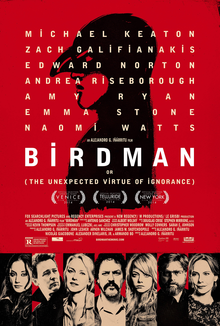Birdman: Or The Unexpected Virtue of Ignorance is Phenomenal
- Carrie Specht

- Nov 3, 2015
- 3 min read

Birdman: Or (The Unexpected Virtue of Ignorance) is a phenomenal film. Written and directed by the lesser-known Alejandro González Iñárittu, it finds its life very much in the technical magic behind the scenes. It is made to look like it is one continuous shot until the end of the movie, where some obvious hard cuts take place. But was it actually one continuous shot? Absolutely not. There are dramatic shifts in setting and time, not to mention the insanity of trying to choreograph every single moving part for nearly two straight hours. So no, the film is not one single shot. Rather, it is a magical tapestry, woven together by the magic of clever cinematography, solid editing, and polished visual effects.
As an aspiring editor, I thoroughly enjoy learning about the inner-workings of the post-production process. I love hearing editors, colorists, sound mixers, and visual effects artists discuss their work and the very specific decisions they made during their time with a particular film. In the case of Birdman, the editors have actually kept a lot of their “secrets” to themselves, but that doesn’t mean their work can’t be dissected from the outside.
When examining the film to find its edits, one of the things that immediately struck me were the interior/exterior transitions. At many places throughout the film, a character will be moving from indoors to outdoors, or from one room to another through a doorway. Often times, the camera pushes in to fill the frame with the character’s back or the area around the doorway is so dark that the frame is briefly entirely dark. Assuming that lighting and color are consistent, a cut can be placed unnoticeably at the point where the frame is completely dark. This particular method is very reminiscent of Alfred Hitchcock’s Rope (1948), where he attempted to make a continuously shot film, but was limited by the amount of film that a camera could hold. To hide the cuts, he had the camera push in to fill the frame with someone’s back. Fortunately for Iñárittu, technology has progressed enormously since Hitchcock’s time. The other two methods of hiding Birdman’s cuts require a little more post-production magic.

The first of these two methods is dramatically simpler than the second. Known as “whip” or “swish” pans, these cuts find their strength in movement. They work by cutting on the action, where the action is blurred because of fast camera movement. The effect is further improved by using a frame rate near the cinematic standard of 24 frames per second. Often times, a well-executed whip pan can even provide an unnoticeable transition between two completely different settings, so a discreet transition between two shots in the same setting is very feasible. Birdman utilizes this technique all over the place, which actually helps add some energy to the film, in addition to its function as a transition.
The final technique used to mask transitions in Birdman is really more of a category than it is a specific technique. “Visual effects” is a broad term than can mean a whole lot of things, but in the context of the cuts in this film, it refers to a method of smoothing transitions. In some cases, such as the small number of exterior shots that showcase the transition from night to day, the effects are more akin to a very complex dissolve. In other cases, they may add some extra blur to a whip pan to make it more believable. Depending on the situation, they may even be a reanimation of some aspect of a cut that makes it almost unnoticeable. Some might consider this category cheating, since it wasn’t how the film was originally shot, but it certainly rounds out the continuous feel of the movie.
Ultimately, I love Birdman because the unique way that it was shot and edited contributes significantly to the film. It isn’t made to look like a continuous shot just for the sake of being different. Rather, the continuous, almost dreamlike flow of the framing assists in characterizing this chapter of Riggan Thomson’s life as confused, dazed, and lost. Birdman is a film worth viewing for its success in accomplishing a technical feat, but more importantly, for how its technical feat contributes to the overall character of the movie.




Comments